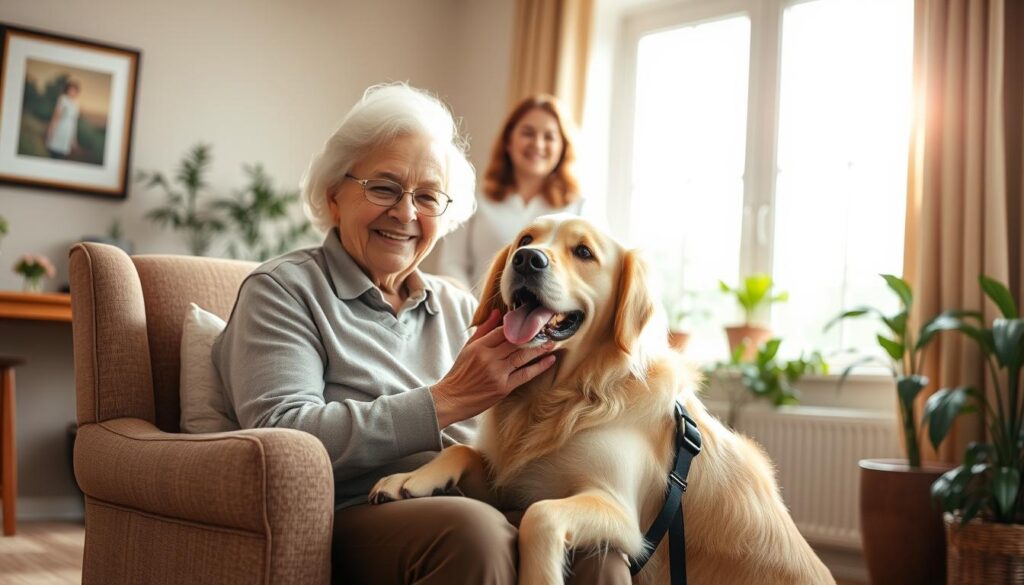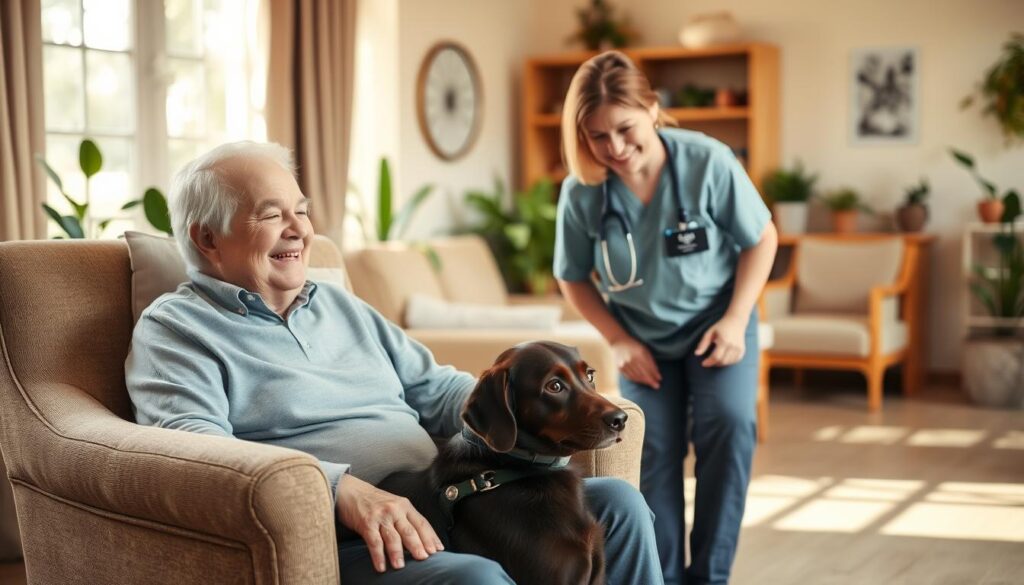- April 18, 2025
Welcome to Dementia World elderly home services



Did you know that about 50 million people worldwide live with dementia? Every year, 10 million new cases are reported. This growing health issue highlights the need for effective support, like animal-assisted therapy (AAT). AAT is known to improve the lives of dementia patients.
It does this by providing emotional support and encouraging social interactions. Dogs, in particular, play a big role in this. They help dementia patients feel better emotionally and socially.
Studies show that AAT can reduce anxiety and agitation in dementia patients. It also helps improve their communication skills. Plus, interacting with animals can lead to positive hormonal changes in the brain. This supports the mental health of those with Alzheimer’s and other dementia types.
Let’s explore how pet therapy can change lives for those with dementia.
Pet therapy is a growing field in dementia care with pet therapy. It offers a caring way to meet the needs of those with dementia. Studies show that animals, like dogs, bring joy and purpose to their lives. This makes their lives better.
With 50 million people worldwide having dementia, using pets in therapy is very important. It shows how pets can help in caring for these individuals.
The benefits of dogs in dementia care go beyond just being friends. They can make people feel happier and less anxious. Just 15 minutes with a pet can release good hormones, making people feel better.
Pet therapy also helps with memory and thinking skills. This is good for seniors with Alzheimer’s, which affects 60% to 80% of dementia patients.
Seeing how dementia patients connect with therapy animals is very telling. Programs like Pets As Therapy help them talk and interact. This is key in fighting off sadness and loneliness.
As more research supports this, using animals in dementia care grows. It leads to a kinder way of treating these patients.
These efforts not only make patients’ lives better but also help caregivers. They create a supportive and loving community.

Dementia is a serious brain disease that affects memory, communication, and mood. As more people get older, understanding dementia becomes key. Alzheimer’s disease, the most common type, causes memory loss and changes in behaviour.
Dementia symptoms include confusion and trouble with daily tasks. This can be very hard for both the person with dementia and their caregivers. It also affects families’ finances and the healthcare system.
Looking for non-drug treatments, like animal-assisted therapy, is becoming more popular. This therapy can help with emotional support and social interaction. It can make life better for those with dementia and their families.
| Care Level | Description | Key Aspects |
|---|---|---|
| Mild Cases | Focus on improving memory and daily help. | Memory games, basic support |
| Moderate Care | Includes health checks and behaviour help. | Regular health visits, support in social activities |
| Advanced Care | Offers full medical care and comfort services. | Constant medical care, emotional support |

Animal-assisted therapy (AAT) uses animals in therapy to help people, like those with dementia. It aims to boost physical, social, emotional, and mental health. Trained animals help under the guidance of health experts.
Studies show animals can lower anxiety and boost mood in dementia patients. They help create a calm space. AAT can also improve memory and motivation, making life better.
AAT offers more than emotional support. It’s a creative way to care for dementia patients. It encourages activity and fights loneliness and depression. Memory dogs can even help with daily tasks, boosting independence.
Pet therapy releases happy hormones like oxytocin and serotonin. It’s a safe, non-drug therapy for dementia care. This makes AAT a valuable tool.

| Benefits of Animal-Assisted Therapy | Impact on Dementia Patients |
|---|---|
| Reduction of Loneliness | Lower risk of depression |
| Improved Memory | Enhanced short-term memory |
| Increased Physical Activity | Encouragement of outdoor walks |
| Emotional Support | Better mood and quality of life |
| Reduced Anxiety | Calmer state of mind |
Pet therapy does more than just keep dementia patients company. It boosts their emotional health. Studies show that pets help release endorphins, which make people feel happy and relaxed. For those with dementia, these emotional health benefits from pets are key, helping to lower anxiety and depression.
Pets offer comfort and a sense of connection, which can be lost in care settings. They create a caring atmosphere, reducing feelings of loneliness. Being around pets can make people happier, boosting their mood and self-esteem. Plus, pets can calm people down, lowering blood pressure and reducing irritability.
Pet therapy boosts social interaction. It connects patients with animals and brings family and staff closer. Sharing moments with pets improves communication in a positive setting. This helps fight loneliness, building a stronger community in care settings.

Adding dogs to dementia care brings many benefits. These advantages boost emotional connections and encourage physical activity. This leads to better health and happiness. Dogs help fight loneliness, a big problem for those with dementia.
Dogs bring great comfort and friendship to those with dementia. Studies show that seniors who live alone may decline faster. But, having a pet can slow down this decline in thinking and memory.
Dogs help create a caring space, building strong emotional bonds. This bond is key in keeping mood stable and improving life quality. It shows how caring for a dog can greatly benefit the elderly.
Walking and playing with dogs helps keep the elderly healthy. Dog owners are more likely to be active, which is good for the brain. These activities help fight dementia and keep the body fit.
Such activities not only improve health but also fight loneliness. They make life more enjoyable and fulfilling.

Using pet therapy in dementia care can greatly improve patients’ lives. Care homes can set up pet visit programmes. This lets patients regularly meet trained therapy animals, boosting engagement.
It’s key to tailor these efforts to each patient’s likes. This way, therapy can be most effective.
Research shows that animal therapy cuts down on agitation in dementia patients. It also boosts social interaction. Therapy animals offer companionship, easing loneliness and isolation.
They help patients feel better emotionally. This can give them a sense of purpose and routine.
Healthcare should use different therapy animals. While dogs are common, miniature horses and ducklings can also help. They can lower blood pressure and encourage eating, fighting malnutrition.
Activities with therapy animals can also improve mobility. Care homes can plan exercises and walks. This helps patients stay active.
Using insights from services like Helping Hands is important. They help create care plans that fit each patient’s needs.
In summary, pet therapy in dementia care is very beneficial. It greatly improves patients’ emotional and physical health.

Care homes are key in adding pet therapy to their programmes. This makes life better and happier for the elderly. It’s a big step in improving their emotional health.
Trained animals visiting regularly bring comfort and companionship. This helps residents feel more stable. Care homes see their residents more engaged and happy.
Letting residents care for pets, like cats or dogs, brings them joy. It also helps with their mental health. This is a big plus for their well-being.
Studies show pet therapy is very beneficial. For example, it greatly reduces anxiety in the elderly. It also cuts loneliness by half. Pets make a big difference in care homes.
Here’s a look at how pet therapy impacts:
| Impact Factor | Control Group | Experimental Group |
|---|---|---|
| Anxiety Reduction (HAM-A) | Minimal Change | Significant Reduction |
| Depression Levels (GDS) | Stable | Notable Decrease |
| Loneliness Scores (UCLA) | High | Significantly Lower |
| Quality of Life (QUALID) | Average | Enhanced |

Care homes can do more than just traditional pet therapy. They can also use virtual visits. This boosts emotional well-being and social interactions. It also increases physical activity by 40%.
Pet visits bring great pet visit benefits for dementia patients. They improve their mood and how they communicate. Studies show that animals can make a big difference. They help reduce anxiety and make talking easier, showing the worth of pet therapy in caring for dementia.
People with dementia often feel anxious or agitated. But, pets can decrease stress and make them feel calm. A visit from a pet can turn their mood around, showing a clear improvement.
The impact of pets on communication is significant. Research shows that pets can spark conversations and help people express themselves. Animals being around can make patients share their thoughts and feelings more easily.

Bringing pets into dementia care can greatly improve patients’ mental and emotional health. Caregivers need to think carefully about each patient’s needs and abilities before making this decision. Here are some key points to consider when introducing pets to dementia care.

First, it’s important to check if the patient can take care of an animal. Many dementia patients may find it hard to feed or walk a pet. Knowing their limits helps choose the right pet for them.
Next, the well-being of both the pet and patient must be a top priority. Pick animals that are calm and easy to adapt to different places. Dogs, for example, are great companions and easier to manage than other pets.
| Factor | Considerations |
|---|---|
| Patient Experience | Previous interaction with pets |
| Health | Allergies, phobias, and ability to interact |
| Living Space | Safety and convenience for both pet and patient |
| Animal Type | Choose calm and manageable pets |
| Alternatives | Robotic pets or therapeutic dolls |
Introducing pets to dementia care can be very positive when done carefully. Thinking about each patient’s likes and health needs makes it better for both the patient and the pet. It creates a warm and friendly environment.
Pet therapy for the elderly with dementia is a key part of caring for them. It meets their emotional, social, and physical needs. Studies and personal stories show it improves mood, social skills, and thinking abilities.
Every time someone with dementia meets a therapy animal, they feel less lonely and anxious. This shows the power of animal companionship.
As more people get dementia, using pet therapy in care plans is becoming more important. Places that use animal therapy see better lives for their residents. They also notice happier staff and better teamwork.
Dogs, cats, and even miniature pigs can make a big difference. They can change the daily lives of those with dementia for the better.
We need to keep researching and using pet therapy in new ways. Improving how we do it and doing more studies will help prove its benefits. This will make sure pet therapy helps as much as it can, making lives richer and building stronger bonds in care settings.
Pet therapy brings emotional support and boosts social interactions. It also lowers anxiety and improves life quality. It gives dementia patients a sense of purpose and emotional fulfilment.
Pet therapy offers companionship and encourages talking. It can be part of care plans. This helps patients, staff, and families have positive interactions.
Animal-assisted therapy uses trained animals to help patients. It improves physical, emotional, social, or cognitive functions. It’s very helpful for those with dementia.
Dogs provide companionship and reduce loneliness. They also encourage physical activity. This improves both emotional and physical health.
Effective strategies include structured pet visits and therapy sessions. Residents can also care for pets. These are tailored to each patient’s needs.
Care homes can make life better by having therapy animals visit. They also let residents care for pets. This improves mental health.
Pet visits can lower anxiety and agitation. They also improve mood and communication skills. This is very beneficial for dementia patients.
Caregivers should check if the patient can care for a pet. They must ensure the pet’s and patient’s welfare. Robotic pets can be an option for those who don’t like live animals.